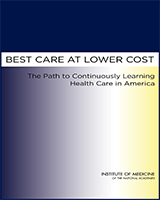NCBI Bookshelf. A service of the National Library of Medicine, National Institutes of Health.
America's health care system has become too complex and costly to continue business as usual. Best Care at Lower Cost explains that inefficiencies, an overwhelming amount of data, and other economic and quality barriers hinder progress in improving health and threaten the nation's economic stability and global competitiveness. According to this report, the knowledge and tools exist to put the health system on the right course to achieve continuous improvement and better quality care at a lower cost.
The costs of the system's current inefficiency underscore the urgent need for a systemwide transformation. About 30 percent of health spending in 2009--roughly $750 billion--was wasted on unnecessary services, excessive administrative costs, fraud, and other problems. Moreover, inefficiencies cause needless suffering. By one estimate, roughly 75,000 deaths might have been averted in 2005 if every state had delivered care at the quality level of the best performing state. This report states that the way health care providers currently train, practice, and learn new information cannot keep pace with the flood of research discoveries and technological advances.
About 75 million Americans have more than one chronic condition, requiring coordination among multiple specialists and therapies, which can increase the potential for miscommunication, misdiagnosis, potentially conflicting interventions, and dangerous drug interactions. Best Care at Lower Cost emphasizes that a better use of data is a critical element of a continuously improving health system, such as mobile technologies and electronic health records that offer significant potential to capture and share health data better. In order for this to occur, the National Coordinator for Health Information Technology, IT developers, and standard-setting organizations should ensure that these systems are robust and interoperable. Clinicians and care organizations should fully adopt these technologies, and patients should be encouraged to use tools, such as personal health information portals, to actively engage in their care.
This book is a call to action that will guide health care providers; administrators; caregivers; policy makers; health professionals; federal, state, and local government agencies; private and public health organizations; and educational institutions.
Contents
- THE NATIONAL ACADEMIES
- COMMITTEE ON THE LEARNING HEALTH CARE SYSTEM IN AMERICA
- Reviewers
- Foreword
- Preface
- Acknowledgments
- Abstract
- Summary
- I. The Imperatives
- II. The Vision
- III. The Path
- 6. Generating and Applying Knowledge in Real Time
- 7. Engaging Patients, Families, and Communities
- 8. Achieving and Rewarding High-Value Care
- 9. Creating a New Culture of Care
- 10. Actions for Continuous Learning, Best Care, and Lower Costs
- ACHIEVING THE VISION
- PATIENTS, CONSUMERS, CAREGIVERS, COMMUNITIES, AND THE PUBLIC
- CLINICIANS AND THEIR TEACHERS
- PROFESSIONAL SPECIALTY SOCIETIES
- DELIVERY SYSTEM LEADERS
- HEALTH INSURERS
- EMPLOYERS
- HEALTH RESEARCHERS
- DIGITAL TECHNOLOGY DEVELOPERS
- HEALTH PRODUCT INNOVATORS AND REGULATORS
- GOVERNANCE
- THE CHALLENGE
- REFERENCES
- Appendix A Glossary
- Appendix B A CEO Checklist for High-Value Health Care
- Appendix C ACA Provisions with Implications for a Learning Health Care System
- Appendix D Biosketches of Committee Members and Staff
Support for this report was provided by the Blue Shield of California Foundation; the Charina Endowment Fund; and the Robert Wood Johnson Foundation. Any opinions, findings, conclusions, or recommendations expressed in this publication are those of the author(s) and do not necessarily reflect the view of the organizations or agencies that provided support for this project.
Suggested citation:
IOM (Institute of Medicine). 2013. Best care at lower cost: The path to continuously learning health care in America. Washington, DC: The National Academies Press.
NOTICE: The project that is the subject of this report was approved by the Governing Board of the National Research Council, whose members are drawn from the councils of the National Academy of Sciences, the National Academy of Engineering, and the Institute of Medicine. The members of the committee responsible for the report were chosen for their special competences and with regard for appropriate balance.
- NLM CatalogRelated NLM Catalog Entries
- The revitalization of U.S. dental education.[J Dent Educ. 2008]The revitalization of U.S. dental education.DePaola DP. J Dent Educ. 2008 Feb; 72(2 Suppl):28-42.
- Working towards a national health information system in Australia.[Medinfo. 1995]Working towards a national health information system in Australia.Bomba B, Cooper J, Miller M. Medinfo. 1995; 8 Pt 2:1633.
- [A proposal for reforming psychologists' training in France and in the European Union].[Encephale. 2009][A proposal for reforming psychologists' training in France and in the European Union].Bouchard JP. Encephale. 2009 Feb; 35(1):18-24. Epub 2008 Apr 2.
- Review Variation in Health Care Spending: Target Decision Making, Not Geography[ 2013]Review Variation in Health Care Spending: Target Decision Making, Not GeographyNewhouse JP, Garber AM, Graham RP, McCoy MA, Mancher M, Kibria A, Committee on Geographic Variation in Health Care Spending and Promotion of High-Value Care, Board on Health Care Services, Institute of Medicine. 2013 Oct 1
- Review Interventional pain management at crossroads: the perfect storm brewing for a new decade of challenges.[Pain Physician. 2010]Review Interventional pain management at crossroads: the perfect storm brewing for a new decade of challenges.Manchikanti L, Singh V, Boswell MV. Pain Physician. 2010 Mar-Apr; 13(2):E111-40.
- Best Care at Lower CostBest Care at Lower Cost
Your browsing activity is empty.
Activity recording is turned off.
See more...
